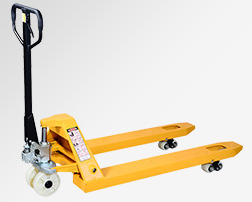News Details
A flexible and practical handling tool for manual hydraulic transport vehicles
As a flexible and practical handling equipment, manual hydraulic trucks have demonstrated unique value in various work scenarios, bringing great convenience to cargo handling work.
In small factories and workshops, space is usually limited, but there are many tasks for cargo handling. The manual hydraulic transport vehicle is compact in size, with a small turning radius, and can move freely in a confined workspace. For example, in a small furniture processing factory, workers can easily transport raw materials such as wood and boards from the storage area to the processing station, or transport processed furniture components to the assembly area, effectively improving production efficiency without occupying too much space resources.

At transportation hubs such as stations and docks, the cargo throughput is enormous. Although manual hydraulic handling vehicles do not have the super strong transport capacity of large loading and unloading equipment, they play an important role in the short distance handling of goods and auxiliary loading and unloading work. At the baggage check-in area of the train station, staff use it to transport passengers' luggage and quickly shuttle between the cargo storage area and transport vehicles, making it convenient and flexible. In the dock warehouse, manual hydraulic handling vehicles can assist in transporting small cargo unloaded from cargo ships to the temporary storage area, and work together with large cranes and other equipment to improve the cargo loading and unloading process.
The manual hydraulic handling vehicle operates purely manually and does not rely on electricity or complex energy supply. It can work as long as it is manually driven, making it particularly suitable for places with inconvenient power supply or strict requirements for fire and explosion prevention, such as some chemical raw material warehouses. Its cost is relatively low, the purchase price is affordable, and maintenance is not complicated. It only requires regular checks of hydraulic oil level, lubrication of moving parts, inspection of fork and wheel wear, etc., to maintain good performance, saving equipment investment and operating costs for enterprises. It has become an ideal choice for many industries to achieve efficient cargo handling in different scenarios.

